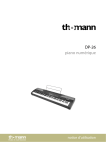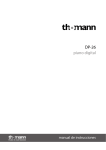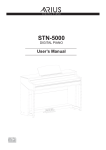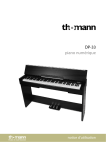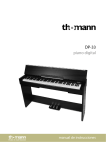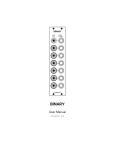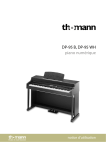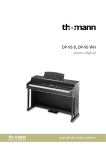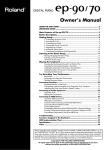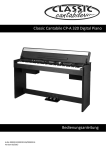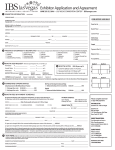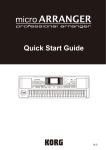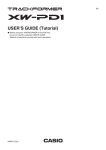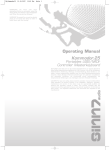Download Manual
Transcript
DP-26 digital piano user manual Musikhaus Thomann Thomann GmbH Hans-Thomann-Straße 1 96138 Burgebrach Germany Telephone: +49 (0) 9546 9223-0 E-mail: [email protected] Internet: www.thomann.de 05.08.2015, ID: 352258 Table of contents Table of contents 1 General information.............................................................................................................. 1.1 Further information........................................................................................................ 1.2 Notational conventions................................................................................................. 1.3 Symbols and signal words........................................................................................... 5 5 5 6 2 Safety instructions................................................................................................................. 7 3 Features....................................................................................................................................... 9 4 Assembly instructions........................................................................................................ 10 5 Control panel and connections..................................................................................... 11 6 Connectivity options.......................................................................................................... 17 7 Switching on / off and basic operation...................................................................... 7.1 Switching the digital piano on................................................................................. 7.1.1 Normal switching on / off....................................................................................... 7.1.2 Automatic shutoff..................................................................................................... 7.2 Adjusting the volume.................................................................................................. 7.3 Touch sensitivity............................................................................................................ 7.4 Fine tuning...................................................................................................................... 7.5 Split point setting......................................................................................................... 7.6 Metronome..................................................................................................................... 7.7 Tempo............................................................................................................................... 7.8 Transposing..................................................................................................................... 7.9 Resonance effect........................................................................................................... 7.10 Digital effects............................................................................................................... 7.10.1 Reverb and Chorus................................................................................................. 7.10.2 Equalizer..................................................................................................................... 7.11 Selecting voices .......................................................................................................... 7.12 Demo songs.................................................................................................................. 7.13 Demo mode.................................................................................................................. 7.14 Dual mode..................................................................................................................... 7.15 Duet mode.................................................................................................................... 7.16 Harmony mode........................................................................................................... 7.17 Split mode..................................................................................................................... 7.18 TWINOVA....................................................................................................................... 7.19 Playing with accompaniment................................................................................ 7.19.1 Style selection.......................................................................................................... 7.19.2 Playing Styles, chord mode................................................................................. 7.19.3 Fill A/B......................................................................................................................... 7.19.4 Accompaniment track volume, muting.......................................................... 7.20 Practise songs.............................................................................................................. 7.20.1 Playing practise songs........................................................................................... 7.20.2 Selecting practise songs....................................................................................... 7.20.3 Practise function right / left hand..................................................................... 19 19 19 19 19 19 20 20 21 21 22 22 22 22 23 23 24 24 24 25 25 26 26 27 27 27 28 28 28 29 29 29 DP-26 3 Table of contents 7.21 Recording function.................................................................................................... 7.21.1 Recording preparation.......................................................................................... 7.21.2 Recording................................................................................................................... 7.21.3 Stopping recording................................................................................................ 7.21.4 Recording playback................................................................................................ 7.21.5 Deleting single recordings.................................................................................. 7.21.6 Deleting all recordings.......................................................................................... 7.22 Historic tunings........................................................................................................... 7.23 MIDI functions............................................................................................................. 7.23.1 What is MIDI?............................................................................................................ 7.23.2 USB connection....................................................................................................... 7.23.3 MIDI connection...................................................................................................... 7.23.4 Controller settings.................................................................................................. 7.23.5 Controller assignment........................................................................................... 7.24 Factory defaults........................................................................................................... 8 Practise and demo songs.................................................................................................. 35 9 Styles list................................................................................................................................... 37 10 Voice list.................................................................................................................................... 38 11 MIDI implementation chart............................................................................................. 39 12 Technical specifications.................................................................................................... 41 13 Plug and connection assignment................................................................................. 42 14 Protecting the environment........................................................................................... 43 digital piano 4 30 30 31 31 31 31 32 32 32 32 32 33 33 34 34 General information 1 General information This manual contains important instructions for the safe operation of the unit. Read and follow the safety instructions and all other instructions. Keep the manual for future reference. Make sure that it is available to all those using the device. If you sell the unit please make sure that the buyer also receives this manual. Our products are subject to a process of continuous development. Thus, they are subject to change. 1.1 Further information On our website (www.thomann.de) you will find lots of further information and details on the following points: Download This manual is also available as PDF file for you to download. Keyword search Use the search function in the electronic version to find the topics of interest for you quickly. Online guides Our online guides provide detailed information on technical basics and terms. For personal consultation please contact our Personal consultation technical hotline. Service If you have any problems with the device the customer service will gladly assist you. 1.2 Notational conventions This manual uses the following notational conventions: Letterings The letterings for connectors and controls are marked by square brackets and italics. Examples: [VOLUME] control, [Mono] button. Displays Texts and values displayed on the device are marked by quotation marks and italics. Examples: ‘24ch’ , ‘OFF’ . DP-26 5 General information Instructions The individual steps of an instruction are numbered consecutively. The result of a step is indented and highlighted by an arrow. Example: 1. Switch on the device. 2. Press [Auto]. ð Automatic operation is started. 3. Cross-references Switch off the device. References to other locations in this manual are identified by an arrow and the speci‐ fied page number. In the electronic version of the manual, you can click the crossreference to jump to the specified location. Example: See Ä ‘Cross-references’ on page 6. 1.3 Symbols and signal words In this section you will find an overview of the meaning of symbols and signal words that are used in this manual. Signal word Meaning DANGER! This combination of symbol and signal word indicates an immediate dangerous situation that will result in death or serious injury if it is not avoided. CAUTION! This combination of symbol and signal word indicates a possible dangerous situation that can result in minor injury if it is not avoided. NOTICE! This combination of symbol and signal word indicates a possible dangerous situation that can result in mate‐ rial and environmental damage if it is not avoided. Warning signs Type of danger Warning – high-voltage. Warning – danger zone. digital piano 6 Safety instructions 2 Safety instructions Intended use This device is intended to be used for electronic sound generation using a piano key‐ board. Use the device only as described in this user manual. Any other use or use under other operating conditions is considered to be improper and may result in per‐ sonal injury or property damage. No liability will be assumed for damages resulting from improper use. This device may be used only by persons with sufficient physical, sensorial, and intel‐ lectual abilities and having corresponding knowledge and experience. Other persons may use this device only if they are supervised or instructed by a person who is responsible for their safety. Safety DANGER! Danger for children Ensure that plastic bags, packaging, etc. are disposed of properly and are not within reach of babies and young children. Choking hazard! Ensure that children do not detach any small parts (e.g. knobs or the like) from the unit. They could swallow the pieces and choke! Never let children unattended use electrical devices. DANGER! Electric shock caused by high voltages inside Within the device there are areas where high voltages may be present. Never remove any covers. There are no user-serviceable parts inside. CAUTION! Possible hearing damage With loudspeakers or headphones connected, the device can produce volume levels that may cause temporary or permanent hearing impair‐ ment. Do not operate the device permanently at a high volume level. Decrease the volume level immediately if you experience ringing in your ears or hearing impairment. NOTICE! Operating conditions This device has been designed for indoor use only. To prevent damage, never expose the device to any liquid or moisture. Avoid direct sunlight, heavy dirt, and strong vibrations. DP-26 7 Safety instructions NOTICE! External power supply The device is powered by an external power supply. Before connecting the external power supply, ensure that the input voltage (AC outlet) matches the voltage rating of the device and that the AC outlet is pro‐ tected by a residual current circuit breaker. Failure to do so could result in damage to the device and possibly the user. Unplug the external power supply before electrical storms occur and when the device is unused for long periods of time to reduce the risk of electric shock or fire. digital piano 8 Features 3 Features The digital piano is characterized by the following features: 88 weighted keys with hammer action LED display Pitch bend wheel 64-voice polyphony 20 voices 50 styles 60 practice and accompaniment songs 2 demo songs 5 memory locations for user recordings Reverb and Chorus effects Master EQ Melody and accompaniment functions Split, duet and duo mode Metronome Transpose function Built-in speakers Connections: 2 × headphone socket, MIDI out, USB-MIDI, sustain pedal, AUX IN, AUX OUT n Automatic shutoff n 12 V power supply included n Sustain pedal included n n n n n n n n n n n n n n n n n DP-26 9 Assembly instructions 4 Assembly instructions Unpack and carefully check that there is no transportation damage before using the unit. Keep the equipment packaging. To fully protect the device against vibration, dust and moisture during transportation or storage use the original packaging or your own packaging material suitable for transport or storage, respectively. Set up the device in the desired location. Operating voltage supply The unit is powered by the included 12 V power supply. Make sure that the device is turned off before you connect it to the power supply or disconnect it. Turn the volume knob counter-clockwise to minimum before connecting the digital piano to the power supply or to other devices. This is to protect the speakers from damage. Connect the cable from the power supply outlet to the input socket [12V] on the rear panel of the piano. Plug the plug of the power cord into a properly wired and earthed mains wall outlet. digital piano 10 Control panel and connections 5 Control panel and connections Overview 1 Built-in speakers. 2 Music stand holder 3 Control panel with function keys and display. 4 Claviature with 88 keys. 5 2 × connection sockets for headphones. 6 Pitch bend wheel for changing the pitch. DP-26 11 Control panel and connections Operating panel Operating elements and function keys with single assignment 7 Button to turn the piano on and off. 8 [VOLUME] Rotary volume control. 17 Display. 21 [DUET] Enables / disables the duet function. 25 [SHIFT] Enables the second button function in combination with one of the buttons [18] … [20] and [22] … [24]. 26 Direct select buttons for voices. Function keys with double assignment normal / MIDI operation No. Button Function in normal operation Function in MIDI operation 10 [TEMPO –] Reduces the playback tempo. Enables the edit mode to assign MIDI mes‐ sages. Increases the playback tempo. Enables the edit mode to enter values. Turns the metronome on and off. Enables the edit mode to assign MIDI chan‐ nels. Starts / stops the playback of demo songs or styles. Enables the edit mode to assign MIDI con‐ trollers. Select button to insert a fill bar. Transferring data from controller 1 or edit controller 1. [COMMAND] 11 [TEMPO +] [DATA] 12 [METRONOME] [CHANNEL] 13 [START / STOP] [MIDI EDIT] 14 [FILL A/B] [CTRL1] digital piano 12 Control panel and connections No. Button Function in normal operation Function in MIDI operation 15 [RECORD] Enables the recording mode. Transferring data from controller 2 or edit controller 2. Starts / stops the playback of user record‐ ings. Transferring data from controller 3 or edit controller 3. [CTRL 2] 16 [PLAY / STOP] [CTRL 3] Function keys with double assignment normal function / key combination operation SHIFT+ No. Button Single function Function in combination with [SHIFT] 9 [DEMO] Enables / disables the demo mode. Enables / disables the MIDI mode. Enables / disables the voice mode. Starts / stops the playback of voices. Enables / disables the style mode. Enables / disables the dual mode. Enables / disables the song mode. Enables / disables the split mode. Decreases the displayed value. Enables / disables the TWINOVA mode. Increases the displayed value. Enables / disables the selection of historic tunings. Enables / disables the transpose function. Enables / disables the harmony mode. [MIDI MODE] 18 [VOICE] [VOICE DEMO] 19 [STYLE] [DUAL] 20 [SONG] [LOWER] 22 [–/NO] [TWINOVA] 23 [+/YES] [SCALE] 24 [TRANSPOSE] [HARMONY] DP-26 13 Control panel and connections Claviature function buttons Press [SHIFT] to enable the following claviature buttons: 27 [BEEP] Turns the key beep of the function keys on and off. 28 [PEDAL RESONANCE] Enables / disables the resonance function for a connected sustain pedal. 29 [TOUCH] Key to adjust the touch sensitivity. 30 [TUNE] Button for fine tuning the claviature. 31 [OCTAVE] Button for octaving the keyboard in TWINOVA mode. 32 [TYPE] Buttons for selecting a historic tuning. 33 [SCALE] Enables / disables the selection of historic tunings. 34 [ROOT] Buttons for selecting the root note of a historic tuning. 35 [REVERB] Buttons for enabling / disabling the reverb effect and to select the reverb type. digital piano 14 Control panel and connections 36 [CHORUS] Buttons for enabling / disabling the chorus effect and to select the chorus type. 37 [EQ] Buttons for selecting a preprogrammed tone colour (EQ type). 38 [DUET] Button for selecting a preprogrammed duet accompaniment (duet type). 39 [HARMONY] Buttons for selecting a preset in harmony mode. 40 [MELODY OFF] Buttons for enabling / disabling the practice mode and to mute the right or left hand voice. 41 [METRONOME] Buttons for selecting the metronome sound. 42 [ACCOMP] Buttons for increasing / decreasing the accompaniment track volume. 43 [TEMPO] Buttons for increasing / decreasing the playback speed. 44 [STYLE] Buttons for selecting a style. 45 [SONG] Buttons for selecting a song. 46 [MIDI] Buttons for setting values in MIDI mode. DP-26 15 Control panel and connections Rear panel connections 47 [USB] USB interface to connect a computer. 48 [MIDI OUT] MIDI out for connecting an external MIDI device. 49 [SUSTAIN] Sustain pedal connection (1/4" phone jack). 50 [AUX IN] Input socket for connecting an external audio device (e.g. MP3 or CD player) (1/4" phone jack). 51 [AUX OUT] Output socket for connecting the digital piano to an amplifier, stereo system, mixer or recording device (1/4" phone jack). 52 [12V] Connection for the power adapter. digital piano 16 Connectivity options 6 Connectivity options Headphones To the left beneath the keyboard you find the headphones outlets 1 and 2. Connecting headphones (not supplied) to outlet 2 mutes the speakers. Using outlet 1 maintains the sound output through the speakers. External audio devices via AUX OUT Use the [AUX OUT] socket to connect the digital piano to an amplifier, stereo device, mixing console or recording device. Plug one end of the audio cable into the [AUX OUT] socket on the rear panel of the digital piano and the other end into the input of the respective audio device. NOTICE! To prevent damage to the speakers, turn the volume down to ‘Min‐ imum’ before you connect other devices to the digital piano. External audio devices via AUX IN Use the [AUX IN] socket to connect a, for example, CD or MP3 player to the digital piano. So you can playback music through the internal speakers of the digital piano and simultaneously play along to it. Plug one end of the audio cable into the [AUX IN] socket on the rear panel of the digital piano and the other end into the output of the respective audio device. Computer via USB You can connect the digital piano to exchange data with a PC via the USB port. MIDI device via MIDI OUT Use the MIDI interface to send MIDI data to an external MIDI device. DP-26 17 Connectivity options Sustain pedal Use the connection socket [SUSTAIN] to connect a sustain pedal to the digital piano. Pedal box You can connect a triple-pedal (Sustain, Sostenuto and Soft) to the digital piano via the connection socket on the bottom of the unit. digital piano 18 Switching on / off and basic operation 7 Switching on / off and basic operation 7.1 Switching the digital piano on 7.1.1 Normal switching on / off Press the power button on the left of the operating panel to turn the digital piano on or off. 7.1.2 Automatic shutoff When the digital piano is not being used for 30 minutes, it switches off automatically. To turn it on again, press the on / off switch on the left of the operating panel. 7.2 Adjusting the volume Adjust the rotary control [VOLUME] for a pleasant volume for playback and practising. Turn this control clockwise to increase the volume. Turn it counter-clockwise to reduce the volume. 7.3 Touch sensitivity With this function you can adjust the touch response of the claviature in four dif‐ ferent levels. Setting Description [OFF] Touch sensitivity is off. This can be very recom‐ mendable when playing the organ voice. [1] Soft In this setting, the volume is higher than usual even when playing with a soft touch. DP-26 19 Switching on / off and basic operation Setting Description [2] Normal This setting corresponds to the usual touch response of a claviature. [3] Hard In this setting, the volume is lower than usual even when playing with a hard touch. Keep the [SHIFT] button pressed and press one of the piano keys in the [TOUCH] area to adjust the touch sensitivity. 7.4 Fine tuning With this function you can fine tune the entire keyboard. 1. Keep the [SHIFT] button pressed and adjust the tuning of the entire keyboard with the piano buttons [TUNE] in a range of a semi tone (= 100 cent). Each time the key is pressed, the value changes 1 Cent upward or downward. 2. Simultaneously press the two piano buttons [TUNE] to reset the tuning of the keyboard back to the default setting. 7.5 Split point setting The split point of the keyboard can be freely selected (default setting: ‘L.19’ = key F#3). 1. Simultaneously press [LOWER] and that key of the claviature where you want to set the split point to. 2. Release both keys. ð The new setting is instantly applied. digital piano 20 Switching on / off and basic operation 7.6 Metronome 1. Turning the metronome on / off Press the function button [METRONOME] to turn the Metronome on or off. When the Metronome is enabled, the LEDs of the [START/STOP] button light up. The red LED will blink with the downbeats. The green LED will blink with the upbeats. 2. Setting the tempo See Ä Chapter 7.7 ‘Tempo’ on page 21. 3. Setting the time signature Keep the [SHIFT] button pressed and set the desired time signature ( ‘0’ … ‘9’ ) with the piano keys [METRONOME]. 4. Setting the metronome sound Keep the [SHIFT] button pressed and use the piano key [VOCAL] to toggle between the settings ‘normal sound’ and ‘human voice’ . Metronome function is not available in song mode. 7.7 Tempo All preprogrammed songs, styles and voices, and the metronome function are stored with certain tempo information. These presets can be adjusted at any time. 1. Tempo adjustment via function keys Press the function buttons [TEMPO +] and [TEMPO –] during playback or with running metronome to adjust the tempo in a range from ‘30’ … ‘280’ . 2. Entering tempo numerically Keep the [SHIFT] button pressed and enter the desired value in a range from ‘30’ … ‘280’ using the piano keys in the [TEMPO] area. Example: To set the tempo 214 bpm you have to press the keys [2], [1] and [4] in the [TEMPO] area successively. 3. Tempo adjustment via TAP function Keep the [SHIFT] button pressed during playback or when the metronome is running and press the [TAP] button twice in succession at the desired tempo. 4. Tempo reset Press the function buttons [TEMPO+]/[TEMPO–] simultaneously to reset the tempo to the factory default setting. DP-26 21 Switching on / off and basic operation 7.8 Transposing With this function you can adjust the pitch of the claviature in semitone steps one octave up or down. 1. Press [TRANSPOSE]. ð The display shows the set value. 2. Use the buttons [NO] and [YES] to adjust the pitch in a range from ‘–05’ … ‘07’ . 3. Press [NO] and [YES] simultaneously to reset the pitch back to factory defaults. 7.9 Resonance effect This effect simulates the lifting of the damper in an analogue keyboard instrument. When pressing the keys, the played notes decay more slowly. 1. Press [SHIFT] and [PEDAL RESONANCE] simultaneously to enable the Resonance effect. 2. Press [SHIFT] and [PEDAL RESONANCE] simultaneously to disable the Resonance effect again. When you turn on the digital piano the resonance effect is disabled by default. Enabling the resonance effect disables the harmony mode. Enabling during playing may cause a slight interruption of sound reproduction. 7.10 7.10.1 Digital effects Reverb and Chorus With the reverb and chorus functions you can simulate acoustic effects under dif‐ ferent environmental conditions. 1. Keep the [SHIFT] button pressed and turn on the desired effect with the piano key [ON/OFF] in the [REVERB ] or [CHORUS] area. 2. Keep the [SHIFT] button pressed and adjust the effects depth with the piano keys [REVERB ] or [CHORUS]. Piano key in the [REVERB] area in the [CHORUS] area [1] Chamber Slight Chorus effect [2] Small hall Medium Chorus effect digital piano 22 Switching on / off and basic operation 7.10.2 Piano key in the [REVERB] area in the [CHORUS] area [3] Large hall Strong Chorus effect [4] Delay Flanger effect [5] Right / left delay Rotating Equalizer The digital piano offers five different EQ presets to select a specific tone colour. Keep the [SHIFT] button pressed and select the desired tone colour with the piano keys [EQ]. Display Equalizer setting ‘1’ Standard ‘2’ Modern ‘3’ Rock ‘4’ Classic ‘5’ Jazz When you turn on the digital piano, the effects are disabled by default and the EQ preset is ‘Standard’. 7.11 Selecting voices The instrument features a selection of 20 authentic voices, see Ä Chapter 10 ‘Voice list’ on page 38. 1. Press [VOICE] or one of the direct selection buttons to activate the last set or a desired voice directly. ð The display shows the number of the selected voice, e.g. ‘0.01’ . 2. Use the buttons [NO] and [YES] or a direct select button to select another voice. Press the [VOICE] button repeatedly to toggle between the upper and lower voice of a direct selection button. DP-26 23 Switching on / off and basic operation 7.12 Demo songs The demo songs incorporated in the digital piano show the sound and the pitch range of the instrument. 1. Press [DEMO] to start playing the demo songs in a continuous loop. ð The display shows ‘d-1’ . The [DEMO] button LED lights. 2. Use [NO] and [YES] to toggle between both demo songs. 3. Press [DEMO] again to stop playing the demo songs. ð The [DEMO] button LED goes out. 7.13 Demo mode In Demo mode, you have the option to preview the individual voices of the digital piano. 1. Use [VOICE] to switch to the voice select mode. 2. Select a voice as described in section Ä Chapter 7.11 ‘Selecting voices ’ on page 23. 3. Press [SHIFT] and [VOICE DEMO] simultaneously to enter the demo mode. 4. Start / stop playing the demo track with [START/STOP]. 5. Press [VOICE] again to exit the demo mode. In Demo mode, the piano keys can not be played. 7.14 Dual mode In Dual mode, you can play two voices simultaneously. 1. First, select the first voice as described in section Ä Chapter 7.11 ‘Selecting voices ’ on page 23. 2. Press [SHIFT] and [DUAL] simultaneously to enter the dual mode. ð The [DUAL] button LED lights. The display shows the preset second voice ‘d.19’ . 3. Use the buttons [NO] and [YES] or a direct select button to select another voice. ð The currently set second voice also appears in the display. If you now press a key, both voices sound simultaneously. 4. Press the [DUAL] button again to exit Dual mode. digital piano 24 Switching on / off and basic operation When the keyboard is split, the Dual mode affects only the keys to the right of the keyboard split point. 7.15 Duet mode In Duet Mode, you can play a complete melody accompaniment by the digital piano automatically by playing a chord with your left hand. 1. Enabling Duet mode Use [DUET] to change to Duet mode. ð The [DUET] button LED lights. The display shows the set Duet type for two seconds, e.g. ‘d01’ and then returns to normal. 2. Selecting Duet type Keep the [SHIFT] button pressed and select the desired Duet type with the piano keys [DUET] ( ‘d01’ … ‘d32’ ). 3. Playing in Duet mode Play a chord with your left hand in the chord area of the claviature (see Ä Chapter 7.5 ‘Split point setting’ on page 20). The melody accompaniment starts automatically. 4. Leaving Duet mode Press the [DUET] button again to exit the Duet mode. The various duet types change with the preprogrammed voices. 7.16 Harmony mode In harmony mode, appropriate harmonic frequencies are automatically added to the notes played. 1. Enabling Harmony mode Press [SHIFT] and [HARMONY] simultaneously to enter the Harmony mode. ð The display shows the standard value ‘oFF’ . DP-26 25 Switching on / off and basic operation 2. Preset selection Keep the [SHIFT] button pressed and select one of the three presets with the piano keys [HARMONY]. 7.17 Preset Display 1+5 ‘H-1’ Octave 1 ‘H-2’ Octave 2 ‘H-3’ Split mode With this function you can split the claviature into two areas and assign different voices. By default, the bass voice is left of the split point. 1. If desired, individually specify the split point as described at Ä Chapter 7.5 ‘Split point setting’ on page 20. 2. Select the right hand voice as described in section Ä Chapter 7.11 ‘Selecting voices ’ on page 23. 3. Press [SHIFT] and [LOWER] simultaneously to enter the Split mode. ð The [LOWER] button LED lights. The display shows the preset split point ‘L. 19’ . 4. Use the buttons [NO] and [YES] or a direct select button to assign a voice for the area to the left of the split point (second voice). ð The currently set second voice also appears in the display. You now have the opportunity to play the digital piano with two different voices. 5. 7.18 Press the [LOWER] button again to exit Split mode. TWINOVA In TWINOVA mode, the keyboard is divided into two areas with the same voice and the same pitch. 1. Voice selection First, select the desired voice (see Ä Chapter 7.11 ‘Selecting voices ’ on page 23). 2. Enabling TWINOVA Press [SHIFT] and [TWINOVA] simultaneously to enter the TWINOVA mode. ð The display shows ‘on’ . 3. Split point setting Simultaneously press [LOWER] and one of the piano keys in the area of C3 … C6 where you want to set the split point to. Release both keys. The new setting is instantly applied. digital piano 26 Switching on / off and basic operation 4. Octave area setting Keep the [SHIFT] button pressed and specify the desired octave range with the piano keys [OCTAVE]. ð The display shows the selected range, e.g. ‘1’ . 7.19 Playing with accompaniment The digital piano features 50 styles to choose from, see Ä Chapter 9 ‘Styles list’ on page 37. 7.19.1 Style selection 1. Use [STYLE] to switch to Style selection. ð The display shows the currently selected Style ( ‘00.1’ by default). The [STYLE] button LED lights. 2. Selection via function buttons Use the buttons [NO] and [YES] to select a style. 3. Selection via Style number Keep the [SHIFT] button pressed and enter the selection number of the Style (see Ä Chapter 9 ‘Styles list’ on page 37) via the piano keys in the [STYLE] area. Example: To set Style 08 you have to press the keys [0] and [8] in the [STYLE] area successively. 7.19.2 Playing Styles, chord mode 1. Start playing the selected Style with [START/STOP]. The chord mode (A.B.C.) is automatically enabled at the same time. ð The [START/STOP] button LEDs are flashing. The area set for the left hand becomes the accompaniment range. Chords played in this area are recognised automatically and used as a base for the accompaniment with the selected Style. 2. Stop playing the Style with [START/STOP]. The chord mode (A.B.C.) is automati‐ cally disabled. DP-26 27 Switching on / off and basic operation 7.19.3 Fill A/B With this function you can insert fill bars in accompaniment mode. 1. In NORMAL mode (main part A), press [FILL A/B] to insert a fill bar. The [FILL A/B] button LED is flashing. After the bar has ended, the digital piano changes to main part B. Die [FILL A/B] button LED lights. 2. In VARIATION mode (main part B), press [FILL A/B] to insert a fill bar. The [FILL A/B] button LED is flashing. After the bar has ended, the digital piano changes to main part A. Die [FILL A/B] button LED goes out. If you keep [FILL A/B] pressed while a Style is being played, the selected fill pattern is played until you release the key. The[FILL A/B] button LED is flashing, as long as you keep the button pressed. 7.19.4 Accompaniment track volume, muting This function allows you to adjust the volume of the accompaniment track to the volume of the claviature or to mute the accompaniment track. 1. Setting the accompaniment track volume Keep the [SHIFT] button pressed. Use the piano buttons [ACCOMP] to adjust the accompaniment track volume in a range from 0 … 127. 2. Muting the accompaniment track Keep the [SHIFT] button pressed. Press the two piano keys [ACCOMP] simultaneously to mute the accompani‐ ment track. The display shows ‘oFF’ . 3. Re-enabling the accompaniment track Press [SHIFT] and the two piano buttons [ACCOMP] simultaneously to re-enable the accompaniment track. ð The display returns to the set volume level of the accompaniment track, e.g. ‘100’ . 7.20 Practise songs The digital piano offers 60 practise songs, where you can mute the right or left hand voice and play this part yourself. digital piano 28 Switching on / off and basic operation 7.20.1 Playing practise songs 1. Use [SONG] to switch to the practise song playback mode. The [SONG] button LED lights. If you press the [SONG] button again all practise songs are played sequentially in a continuous loop. If you press the [START/STOP] button the currently displayed practise song will be repeated in a continuous loop. During playback, the LEDs of the [START/STOP] button are flashing. The red LED will blink with the downbeats. The green LED will blink with the upbeats. The display shows the number of the song being played, e.g. ‘001’ . 7.20.2 2. Press [START/STOP] again to stop the playback. 3. Press [SONG] again to exit the mode. 1. Selection via function buttons Selecting practise songs Use [SONG] to switch to the practise song playback mode. The [SONG] button LED lights. Use the buttons [NO] and [YES] to select a song. 2. Selection via song number Use [SONG] to switch to the practise song playback mode. The [SONG] button LED lights. Keep the [SHIFT] button pressed and enter the selection number of the song (see Ä Chapter 8 ‘Practise and demo songs’ on page 35) via the piano keys in the [SONG] area. Example: To set Song 08 you have to press the keys [0] and [8] in the [SONG] area successively. 3. 7.20.3 Press the [MELODY OFF] button, to mute the right hand voice. ‘MELODY OFF’ lights up in the display and you only hear the left hand voice. Press the [MELODY OFF] button again if you want to re-enable the track. Practise function right / left hand All 60 songs can be used for practising. Keep the [SONG] button pressed in Practise mode and specify with the piano buttons in the [MELODY OFF] area which hand you want to practise with. Press the [OFF] button to exit the Practise mode. DP-26 29 Switching on / off and basic operation 1. Left hand practise Use [SONG] to switch to the practise song playback mode. The [SONG] button LED lights. Simultaneously press [SHIFT] and the piano key [L] in the [MELODY OFF] area to mute the area to the left of the split point of the claviature for practising the left hand. 2. Right hand practise Use [SONG] to switch to the practise song playback mode. The [SONG] button LED lights. Simultaneously press [SHIFT] and the piano key [R] in the [MELODY OFF] area to mute the area to the right of the split point of the claviature for practising the right hand. 3. Leaving Practise mode Press the [OFF] button in the [MELODY OFF] area to exit the Practise mode. 7.21 Recording function You can record your own songs with the digital piano and save up to five recordings as user songs in the internal memory. Unsaved recordings are retained in the clip‐ board memory after switching the digital piano off. 7.21.1 Recording preparation 1. Use [RECORD] to change to recording mode. ð The [RECORD] button LED lights. The display shows the number of the first free memory location for user-songs ‘nFx’ . 2. Use [NO] and [YES] to select a free memory location for the recording. Occupied locations are shown in the display as ‘r-x’ . These recordings can be overwritten at any time, but not be restored! 3. Press [RECORD] again to record enable the digital piano. ð The [START/STOP] button LEDs are flashing. 4. If desired, select an accompaniment (Style Ä Chapter 7.19.1 ‘Style selection’ on page 27 or Voice Ä Chapter 7.11 ‘Selecting voices ’ on page 23) and set the recording tempo (Ä Chapter 7.7 ‘Tempo’ on page 21). digital piano 30 Switching on / off and basic operation 7.21.2 Recording 1. Recording without accompaniment The recording starts with the first keystroke. 2. Recording with accompaniment Press the [START/STOP] button in record enable mode to start recording. The chord mode (A.B.C.) is automatically enabled at the same time. The recording starts as soon as you play the first chord in the chord area to the left of the split point of the claviature ( Ä Chapter 7.5 ‘Split point setting’ on page 20). 7.21.3 Stopping recording With [RECORD] you can cancel or stop recording at any time. The recording is automatically stored in the device. The display shows ‘---’ . Once the saving is complete, the [RECORD] button LED will turn off. When the storage capacity is reached, recording will stop automatically and the recorded data will be stored. While storing, the indicator flashes quickly. The display shows ‘FUL’ . 7.21.4 Recording playback 1. Use [PLAY/STOP] to switch to the playback mode for user songs. 2. Use [NO] and [YES] to select a recording from the memory ( ‘P-1’ … ‘P-5’ ). 3. Press [PLAY/STOP] to play the user song. ð The [PLAY/STOP] button LED lights. 4. Press [PLAY/STOP] again to stop the playback. ð The [PLAY/STOP] button LED goes out. 7.21.5 Deleting single recordings 1. Use [PLAY/STOP] to switch to the playback mode for user songs. 2. Use [NO] and [YES] to select a recording you want to delete. 3. Press [RECORD]. ð The confirmation prompt ‘dEL’ appears in the display. 4. Confirm with [YES] to delete the recording. Press [NO] to cancel the process. DP-26 31 Switching on / off and basic operation 7.21.6 Deleting all recordings 1. Turn off the digital piano. 2. When turning it back on again, keep the buttons [RECORD] and [PLAY/STOP] pressed. ð All user songs will be deleted without further confirmation prompt. 7.22 Historic tunings With this function, you can experiment with different historical tunings when playing certain musical genres that have not been composed based on equal temperament. 7.23 7.23.1 1. Press [SHIFT] and [SCALE] simultaneously to enter the mode ‘Historic tunings’. The display briefly shows ‘on’ and then changes to the last setting. By default, ‘001’ (Pythagoras) is set as historic tuning. 2. Keep the [SHIFT] button pressed and select the desired historic tuning with the piano keys [SCALE] and [TYPE]: Pythagoras, pure major, pure minor, middle tone, Werckmeister or Kirnberger. 3. Keep the [SHIFT] button pressed and select the root note of the selected tuning with the piano keys [SCALE] and [ROOT]. 4. Press [SCALE] again to exit the mode ‘Historic tunings’. MIDI functions What is MIDI? MIDI stands for ‘Musical Instrument Digital Interface’ and represents the standard interface between a computer and electronic instruments. You can use the USB port or the MIDI output socket of the digital piano for transferring MIDI data to a com‐ puter or other USB device. 7.23.2 USB connection 1. Connect the USB port of the digital piano using a standard USB cable (not included) to the USB port on your computer. digital piano 32 Switching on / off and basic operation 2. Observe the following instructions when connecting USB instruments to com‐ puters. Otherwise, the instrument or the computer may ‘crash’, which can result in data loss. If a ‘crash’ should occur, turn off computer and instrument and restart both after a few seconds. – – 7.23.3 If the computer is in standby or hibernation, wake the computer before connecting the USB cable. Establish the USB connection between computer and instrument before turning on the instrument. MIDI connection At MIDI connections, the device that controls other devices, is referred to as the Master. A device that is controlled via MIDI is called Slave. Connect the MIDI OUT of the master to the MIDI IN of the slave. 7.23.4 Controller settings The digital piano has three built-in controllers to control another device. 1. Press [SHIFT] and [MIDI MODE] simultaneously to enter the MIDI mode. ð The [MIDI MODE] button LED lights. 2. Press [MIDI EDIT] to enter the Edit mode. 3. Use [CTRL 1], [CTRL 2] and [CTRL 3] to enable the controller you want to adjust. 4. MIDI commands Press [COMMAND] to enable the selection of MIDI messages. The display shows the current setting, the dot behind the [VOICE] display is flashing. Keep the [SHIFT] button pressed and use the piano keys [0] … [9] in the [MIDI] area to enter the number of the MIDI command you want to assign to the active controller: Number Display MIDI command 000 … 127 ‘0.00’ … ‘1.27’ Standard MIDI command 128 ‘.Cn’ Programme change 129 ‘.dn’ Aftertouch 130 ‘.En’ Pitchbend wheel DP-26 33 Switching on / off and basic operation 5. MIDI values Press [DATA] to enter a MIDI value. The display shows the current setting, the dot behind the [STYLE] display is flashing. Keep the [SHIFT] button pressed and use the piano keys [0] … [9] in the [MIDI] area to enter a value between 000 … 127. 6. Channel assignment Press [CHANNEL] to assign a MIDI channel. The display shows the current set‐ ting, the dot behind the [SONG] display is flashing. Keep the [SHIFT] button pressed and use the piano keys [0] … [9] in the [MIDI] area to enter a channel number between 01 … 16. 7.23.5 7. Adjust the other channels as described. 8. Use [MIDI EDIT] to exit the Edit mode. 1. Press [SHIFT] and [MIDI MODE] simultaneously to enter the MIDI mode. Controller assignment ð The [MIDI MODE] button LED lights. 2. Use [CTRL 1], [CTRL 2] and [CTRL 3] to select the controller for sending MIDI data. ð The LED of the corresponding button flashes while the digital piano sends MIDI data. When all data is transferred, the LED lights solid. 7.24 3. If desired, press the button again to resend the data. 4. Press [SHIFT] and [MIDI MODE] simultaneously to exit the MIDI mode. Factory defaults Proceed as follows to restore the factory default settings: 1. Turn off the digital piano. 2. When turning it back on again, keep the buttons [YES] and [NO] pressed. ð All user songs and settings are reset or deleted without further confirma‐ tion prompt. The display shows ‘---’ . digital piano 34 Practise and demo songs 8 Practise and demo songs No. Name No. Name 001 Waltz in A Flat Op.39, No.15 031 Mazurka 002 The Happy Farmer 032 Minuet 1 003 Etude 033 Minuet 2 004 Dance Of The Four Swans From ‘Swan Lake’ 034 Minuet 3 005 Carmen Suite No.2 Habanera 035 Minuet In G 006 A Little Polish Dance 036 Neapolitan Song 007 Jesus Saviour Pilot Me 037 Prelude 008 Old Macdonald Had A Farm 038 Salut D' Amour 009 O Sole Mio 039 Pizzicato Polka 010 Wedding March From ‘Lohengrin’ 040 Piano Sonata In A major, K331. 011 2-Part Invention No.13 In A Minor BWV 784 041 Op30 No .6 F sharp minor Venetian Gondola Song 012 Turkish March 042 Duke Aria From ‘The Rigoletto’ 013 Italian Polka 043 Burgmuller Op.100 No.15– Ballade 014 Musette 044 Spinning Song 015 Bourree 045 In The Theatre 016 To A Wild Rose 046 Alfredo and Violetta Column Tower Duet 017 Away In A Manger 047 Come Back To Sorrento 018 Fur Elise 048 Piano Sonatina In F Major 019 Marriage Of Figaro 049 Tchaikovsky Waltz 020 Angels We Have Heard On High 050 Military March No.1 In D Major 021 Waltz 051 Als Die Alte Mutter Mich Noch lehrte Singen 022 America The Beautiful 052 Etude on Leger Lines 1 023 Did You Ever See A Lassie 053 Etude on Leger Lines 2 024 Arabesque 054 At the Ball 025 Old France 055 Dancing Raindrops 026 Santa Claus Is Coming To Town 056 From a Story Book 027 Music Box Dancer 057 Comin' 'Round the Mountain 028 Symphony No.9 In E Minor Largo From ‘The New World’ 058 Song of the Brook 029 Larghetto 059 Puck 030 French Suites 060 Cotton-pickin' Fingers DP-26 35 Practise and demo songs Demos No. Name 001 Fantasia 002 Chpn_op25_no1 digital piano 36 Styles list 9 Styles list No. Name No. Name No. Name 001 Romantic 8beat 018 Jazz 3 035 Jazz Blues 002 Pop 8Beat 019 Jazz 4 036 Piano Beat 003 Slow Rock 020 Jazz 5 037 Piano Bar 004 Lyric 3Beat 021 Boogie 038 Pop 1 005 Pop Waltz 022 Jive 039 Pop 2 006 Slow Waltz 023 Dixland 040 Pop 3 007 Waltz 1 024 Latin 041 Pop 4 008 Waltz 2 025 Tango 042 Pop Country 009 Waltz 3 026 Lambada 043 Pianist 1 010 Vienna Waltz 027 Samba 044 Pianist 2 011 March 1 028 ChaCha 045 Ballad 1 012 March 2 029 Beguine 046 Ballad 2 013 Polka 030 Salas 047 Ballad 3 014 Italian Polka 031 Pop Bossa 048 Ballad 4 015 Jazz Pub 032 Blues 1 049 6/8 Ballad 016 Jazz 1 033 Blues 2 050 6/8 Ballad 2 017 Jazz 2 034 Blues 3 DP-26 37 Voice list 10 No. Voice list Name Piano No. Name No. 008 Vibraphone Guitar 001 Grand Piano Organ 002 Grand Piano 2 009 003 Ele. Piano 004 Name 016 Acoustic Guitar (nylon) Percussive Organ 017 Electric Guitar (clean) 010 Drawbar Organ Bass Ele. Piano 2 011 Church Organ 018 005 Ele. Piano 3 012 Reed Organ Strings & Orchestral Instruments 006 Harpsichord 013 Rock Organ 019 String Ensembles Chromatic Percussion 014 Accordion 020 Synth Strings 007 015 Harmonica Clavi digital piano 38 Electric Bass (finger) MIDI implementation chart 11 MIDI implementation chart Function Basic Channel Mode Note Number Velocity Note Sent Received Default 1 ALL Changed 1-16 1-16 Default No Mode 3 Messages No Mode 3 Altered *********** No Note 0 – 127 0 – 127 True voice ******** 0 – 127 Note ON Yes, 9nH, Yes, 9nH, v = 1 – 127 v = 1 – 127 No, 9nH, Yes, 9nH, v=0 v = 0 or 8nH, v = 0 – 127 Keys No No Channels No No No Yes 0 Yes Yes Bank Select 1 No Yes Modulation 5 No Yes Portamento Time 6 Yes Yes Data Entry 7 Yes Yes Volume 10 No Yes Pan 11 No Yes Expression 64 Yes Yes Sustain Pedal 65 No Yes Portamento ON/OFF 66 Yes Yes Sostenuto Pedal 67 Yes Yes Soft Pedal 80 No Yes Reverb Program 81 No Yes Chorus Program 91 Yes Yes Reverb Level 93 Yes Yes Chorus Level 120 No Yes All Sound Off 121 No No Reset All Controllers 123 Yes Yes All Notes Off Note OFF After Touch Pitch Bend Control Change Notes DP-26 39 MIDI implementation chart Function Program Change Sent Received Yes Yes *********** 0 – 127 No Yes Song Position Pointer No No Song Select No No Tune Request No No Clock Yes No Commands No *1 No *1 Local ON/OFF No No ALL Notes OFF Yes Yes Active Sensing Yes Yes System Reset No Yes True # System Exclusive System Common System Real Time Aux Messages MIDI channel modes POLY MONO OMNI ON Mode 1 Mode 2 OMNI OFF Mode 3 Mode 4 digital piano 40 Notes Technical specifications 12 Technical specifications Keyboard 88 weighted keys with hammer action Polyphony 64-voice Voices 20 Styles 50 Practising songs 60 Demo songs 2 Pedal connection options Soft, Sostenuto, Sustain Connections 2 × head phones (1/4" jack), AUX IN, AUX OUT, USB, MIDI out Speaker 2 × 10 W @ 4 Ω 2 × 25 W @ 8 Ω Operating supply voltage AC 230 V Dimensions (W × H × D) 1510 mm × 230 mm × 480 mm Colour Black Weight 12.1 kg DP-26 41 Plug and connection assignment 13 Plug and connection assignment Introduction This chapter will help you select the right cables and plugs to connect your valuable equipment in such a way that a perfect sound experience is ensured. Please note these advices, because especially in ‘Sound & Light’ caution is indicated: Even if a plug fits into the socket, an incorrect connection may result in a destroyed power amp, a short circuit or ‘just’ in poor transmission quality! Balanced and unbalanced transmis‐ sion Unbalanced transmission is mainly used in semi-professional environment and in hifi use. Instrument cables with two conductors (one core plus shielding) are typical rep‐ resentatives of the unbalanced transmission. One conductor is ground and shielding while the signal is transmitted through the core. Unbalanced transmission is susceptible to electromagnetic interference, especially at low levels, such as microphone signals and when using long cables. In a professional environment, therefore, the balanced transmission is preferred, because this enables an undisturbed transmission of signals over long distances. In addition to the conductors ‘Ground’ and ‘Signal’, in a balanced transmission a second core is added. This also transfers the signal, but phase-shifted by 180°. Since the interference affects both cores equally, by subtracting the phase-shifted signals, the interfering signal is completely neutralized. The result is a pure signal without any noise interference. 1/4" TRS phone plug (stereo, unbal‐ anced) 1 Signal (left) 2 Signal (right) 3 Ground digital piano 42 Protecting the environment 14 Protecting the environment Disposal of the packaging material For the transport and protective packaging, environmentally friendly materials have been chosen that can be supplied to normal recycling. Ensure that plastic bags, packaging, etc. are properly disposed of. Do not just dispose of these materials with your normal household waste, but make sure that they are collected for recycling. Please follow the notes and markings on the packaging. Disposal of your old device This product is subject to the European Waste Electrical and Electronic Equipment Directive (WEEE). Do not dispose with your normal household waste. Dispose of this device through an approved waste disposal firm or through your local waste facility. When discarding the device, comply with the rules and regulations that apply in your country. If in doubt, consult your local waste disposal facility. DP-26 43 Notes digital piano 44 Notes DP-26 45 Notes digital piano 46 Musikhaus Thomann · Hans-Thomann-Straße 1 · 96138 Burgebrach · Germany · www.thomann.de
















































